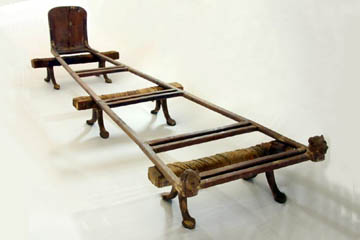The Airfix Bed
There was considerable excitement back in 2005 when a new tomb was discovered in the Valley of the Kings by the American-Egypian mission and I was curious to see it, particularly after video of the tomb was made available to the world's press. Needless to say the video consisted of a few quick glimpses of the tomb and its contents and lengthy shots of the ubiquitous Zahi Hawass speculating about the tomb and being, as usual, totally wrong about it.
More mature investigation has revealed that the "tomb", labelled KV63, may really have been nothing more than a workshop, so my disappointment at walking past the hole in the ground between the tomb of Horemhab and that of Tutankhamun and seeing nothing apart from some workmen smoking is considerably ameliorated.
The hole in the ground contained 28 clay jars of different sizes, some embalming materials - resins, oils, herbs and linen bandages - and seven empty coffins. It was the presence of the anthropoid coffins that led the initial discoverers to refer to it as a tomb and the fact that they were empty caused considerable disappointment and puzzlement.
However it was the contents of one of the large clay jars that caused the most puzzlement. Inside the jar were pieces of wood of different sizes and shapes. Referred to initially as "plaques", this was soon realised to be a misnomer for there were no inscriptions on the wooden pieces, some of them were more like rods than plaques, and though four were carved to resemble the heads of a lion and lioness, that is not really the definition of "plaque".

|
| The reassembled bed. The head of the bed is towards the right and the upright piece is at the foot. Note how the bed is wider at one end. |
After considerable experimentation by Amani Nashed, an Egypian conservator, the pieces have been assembled to form the frame of a bed. Given the other contents of the tomb it is not unreasonable of the Americans to call it an embalming bed, though some of their other speculations are perhaps less trustworthy.
The bed slopes down slightly at one end and the team speculates that this was to allow the body fluids to drain away while the body lay for 40 days on the bed. In the first place we have no information as to which end of the bed was the foot - for all we know the body's head may have been lower than its feet, or even the other way round - but whichever way the body was placed, there is no opening at either foot or head through which liquids could drain. There is little to be gained by having either the head or the feet swollen by accumulated liquid!
In addition the bed, which is 5'6" long, only appears to be a foot or so high, considerably less than the height of embalming beds depicted in Egyptian wall paintings and a 2" drop at one end is not much of a slope and would hardly make much of a difference to the distribution of fluids in a dead body. It is just as likely that slope is due to the carpenter running out of wood!
Some may be puzzled as to why the bed was in pieces and inside a jar. We today know that the Valley of the Kings is so dry that it acts as an excellent preservative, but the ancient Egyptians may not have been so well informed. Wood was an expensive commodity but at the same time liable to damage from various insects, including wood-eating termites. If this kit was part of a portable embalming workshop that went from place to place to minister to the dead, disassembling the bed and putting its components in a clay jar where they would be safe from voracious insects makes excellent sense.
© Kendall K. Down 2009





